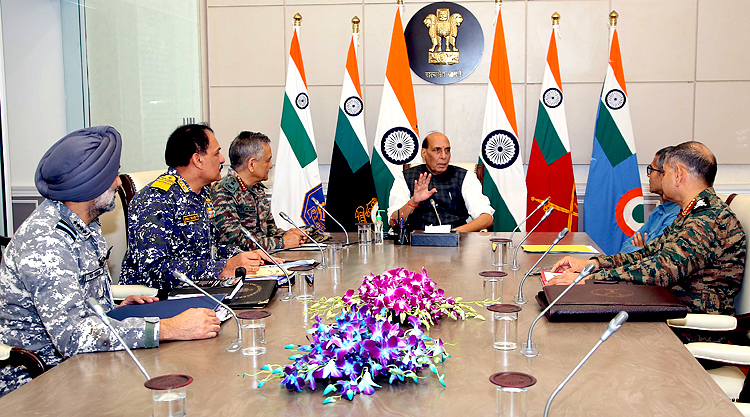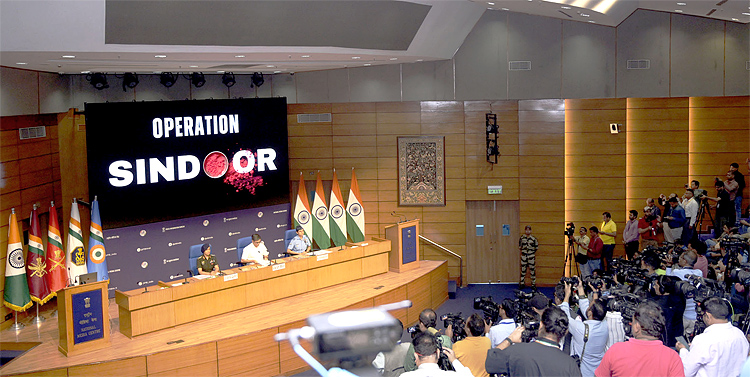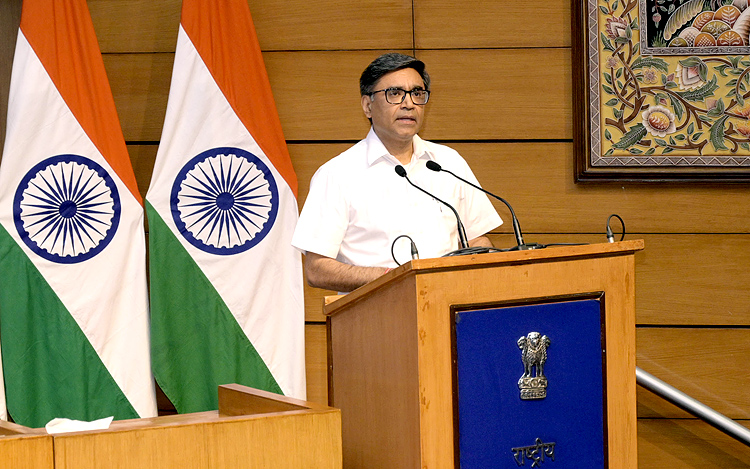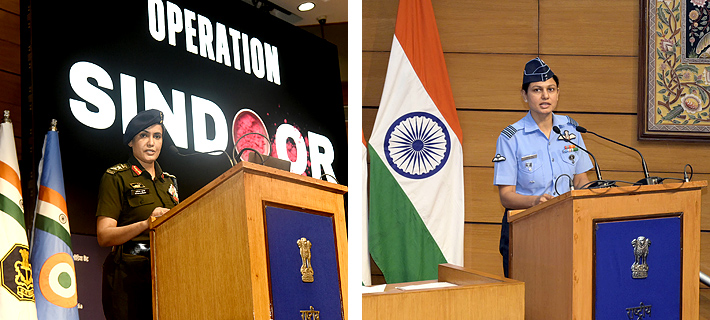INDIAN ARMED FORCES CHIEFS ON OUR RELENTLESS AND FOCUSED PUBLISHING EFFORTS

The insightful articles, inspiring narrations and analytical perspectives presented by the Editorial Team, establish an alluring connect with the reader. My compliments and best wishes to SP Guide Publications.

"Over the past 60 years, the growth of SP Guide Publications has mirrored the rising stature of Indian Navy. Its well-researched and informative magazines on Defence and Aerospace sector have served to shape an educated opinion of our military personnel, policy makers and the public alike. I wish SP's Publication team continued success, fair winds and following seas in all future endeavour!"

Since, its inception in 1964, SP Guide Publications has consistently demonstrated commitment to high-quality journalism in the aerospace and defence sectors, earning a well-deserved reputation as Asia's largest media house in this domain. I wish SP Guide Publications continued success in its pursuit of excellence.
- Global Partners Urged to Tap India's Shipbuilding Potential: Rajnath Singh at Samudra Utkarsh
- All about HAMMER Smart Precision Guided Weapon in India — “BEL-Safran Collaboration”
- India, Germany deepen defence ties as High Defence Committee charts ambitious plan
- G20 Summit: A Sign of Global Fracture
- True strategic autonomy will come only when our code is as indigenous as our hardware: Rajnath Singh
- India–Israel Joint Working Group Meeting on defence cooperation to boost technology sharing and co-development
Operation Sindoor: Resolute yet Restrained
The operation was designed to be clearly viewed as a pure anti-terror operation as a right to respond to a terror attack as per UN conventions
 |
The Author is former Chief of Staff of a frontline Corps in the North East and a former helicopter pilot. He earlier headed the China & neighbourhood desk at the Defence Intelligence Agency. He retired in July 2020 and held the appointment of Addl DG Information Systems at Army HQ. |

The Pahalgam massacre was a dare to test the resolve of Bharat. Operation Sindoor has answered that dare and at the same time, demonstrated a characteristic restraint that behoves a mature old civilisation. The terrorists had a clear agenda and a well-rehearsed plan of execution. Men were pulled aside, asked to recite Kalma and double checked by forcing them to pull their pants down for positive verification before being shot in cold blood in front of their wives and children. "Go, tell Modi," said one of the terrorists after shooting a man dead in front of his wife.
Operation Sindoor has demonstrated a characteristic restraint that behoves a mature old civilisation
The Prime Minister has responded, with Operation Sindoor. But not before allowing a 13-day period ritual, that is set aside by Hindus for grieving, recollection, and prayers, allowing family members to grieve, seek solace, and honour the path of the departed spirit. The symbolic goodbye, a last farewell to the departed soul was over. It was time for retribution. The pain and anguish of a billion people had to be addressed.
Political-Military Synchrony: A Unified National Response
While the family members and their kith and kin and the larger community grieved in silence, the corridors of power in New Delhi were humming with activities. The Cabinet Committee on Security (CCS) held sessions followed by the Cabinet Committee on Political Affairs (CCPA) and all party meetings. Armed Forces Chiefs were consulted, individually and together by the National Security Advisor Ajit Doval, by the Defence Minister Rajnath Singh and by the Prime Minister. There was complete politico-military congruence unlike the situation in 1971 where they differed sharply, with then Prime Minister Indira Gandhi calling for immediate action in April while General (later Field Marshal) Sam Manekshaw bluntly refused her push for a monsoon campaign, warned about the dangers of getting bogged down and advocated conducting a military campaign after the monsoons, ideally, late November, to minimise the Chinese threat, and ensure the superior concentration of forces for assured success.

The Armed Forces have been given full freedom to plan the operation, select their targets and decide on the methodology of delivery. The final go ahead for Operation Sindoor was given after keeping key global allies like the US, Russia, the UK, the Kingdom of Saudi Arabia and UAE in the loop. The operation was focussed, measured and non-escalatory, not targeting any Pakistani military facility but the full spectrum of the major terrorist outfits including the Lashkar-e-Taiba (LeT), Jaish-e-Mohammed (JeM) and Hizbul Mujahideen. There were five targets in Pakistan occupied Jammu & Kasmir (PoJK) and four in Punjab State of Pakistan, the closest (Sarjal Camp opposite Samba-Kathua) about 8 kms from the Line of Control (LoC) and the deepest (Bahawalpur) a 100 kms from the international border (IB), both housing the JeM. No Indian aircraft crossed the LoC or the IB.
The Armed Forces have been given full freedom to plan the operation, select their targets and decide on the methodology of delivery
A package of long-range cruise missiles like the SCALP, precision glide bombs like HAMMER and loitering munitions or kamikaze drones like SkyStriker may have been used based on the distanced and nature of the targets. All intended targets were precisely hit, overcoming any Pakistani air defence that may have been active at the time. It demonstrated a capability to the world that was hitherto a preserve of the US and Israel. The objectives were clear, re-establish deterrence that was effected after the Balakot strike but had got diluted with passage of time and change of command in the Pakistani Army, assure the domestic audience and deliver an international messaging. The operation was designed to be clearly viewed as a pure anti-terror operation as a right to respond to a terror attack as per UN conventions.


For the victims of the Pahalgam attack and their families, this strike at the heart of Pakistan's terror infrastructure has brought joy. Asvari Jagdale, daughter of Santosh Jagdale, one of the victims of the Pahalgam terror attack said, "We were crying with happiness. Modi has taken revenge, and the way the operation was named, our tears wouldn't stop. Those sisters whose sindoor (symbol of marital status) was erased by these terrorists--India has struck them at nine locations. It feels truly different, and our tears of joy just won't stop."
Escalation and Indian Defence Superiority
The conflict has widened since. Dramatic subsequent developments unfolded as Pakistan initiated its wave of airstrikes, focusing on cities and military bases across J&K, Rajasthan, Punjab and Gujarat. These drone and missile attacks were completely foiled by the Indian Air Defence Systems and not one target was hit by Pakistan. In retaliation of these attack on military bases, India responded to by hitting Lahore, Sialkot and Rawalpindi.
Starting around 8:30 PM on Thursday, strategic military targets in Jammu, Pathankot, Poonch, Udhampur, Amritsar, Jalandhar, Chandigarh and Bathinda were targeted with drones and rockets from Pakistan which were effectively neutralised by our robust air defence system, using the full array of S-400s (400 kms range), Barrak (75 kms), Akash (25 kms), Spyker (15 kms) and Igla- S (6 kms) apart from the quintessential L-70 guns. Amid the aerial aggression, large-scale power outages were reported in Srinagar, Jammu, and various parts of Punjab and Rajasthan, plunging several regions into darkness and uncertainty. Indian army launched a potent retaliation, decimating several Pakistani military posts situated along the LoC. Precision strikes, including the use of anti-tank guided missiles, were employed to dismantle enemy positions.


Heavy exchange of artillery shelling is causing loss of lives and property in border towns. India has struck Rawalpindi, Lahore and Karachi to destroy Pakistan's air defence systems, radars and AWACS. Indian Navy has carried out a major military operation targeting Karachi Port. Several explosions were reported near the port area of Karachi on Thursday evening, with unconfirmed reports suggesting missile strikes on key Pakistani naval bases. While operations from both sides are ongoing, summarising the situation at present, it is evident that while Indian missiles and drones are able to hit their targets bypassing the Pakistani air defences, Pakistani retaliations by barrages of drones and missiles have been effectively neutered by own air defence systems.
Strategic Isolation of Pakistan and the Global Diplomatic Landscape
Meanwhile, the US has declined to mediate. The World Bank under President Ajay Banga has declared that it won't interfere with the Indus Water Treaty abeyance. This will hit Pakistan's economy, especially its agriculture and hydro-power generation very hard, further exacerbating its precarious financial situation. Except perhaps China, Turkey and Iran to an extent, Pakistan has few backers left and is growing isolated. India is being given a free hand to deal with Pak sponsored radical Islamic terrorism.
Balkanisation of Pakistan and removal of nuclear weapons from its soil together with a complete decimation of the Pakistan army which is the real terror factory, will be the long term goals
The irony of the situation is that Pakistan, the fountainhead of terrorism, sits on the UN Security Council as a rotational non-permanent member. It can thus effectively dilute any council resolutions since they must be unanimous. It is another matter that the UN has lost much of its effectiveness and relevance, especially in the past two decades after it was bypassed by the US to invade Iraq in 2003. There has been little visibility or impact of UN mediation or international intervention to resolve either the over three-years-war in Ukraine or the over 18-months old Gaza crisis. Yet India has deployed its full armoury of diplomacy and successfully, to keep global opinion firmly in its favour. Apart from close allies like Russia, countries like the US, the UK, France, Israel, the Netherlands, and even a non-permanent member of the UNSC, Panama, have not only acknowledged India's right to self-defence but have also explicitly supported Operation Sindoor's objective of dismantling terrorist infrastructure operating from Pakistani soil.
The End Game?
When and how the current round of conflict will see a closure is difficult to speculate. The Baluch Liberation Army (BLA) and the Tehreek e Taliban Pakistan (TTP) have stepped up their assault on Pakistan security forces causing fatal casualties and gaining ground. The chances of Baluchistan separating from Pakistan is more of a possibility now than ever. Coupled with TTP advances and their close coordination with BLA, Pakistan Army faces a double whammy it is hardly equipped to handle. It would be logical to expect that a change of baton in the Pakistan Army now being led by a rabidly fundamentalist General Asim Munir, balkanisation of Pakistan, and a possibility of PoJK re-joining the Indian Union are possibilities.
India encounters a situation not very different from what Israel has confronted since its birth as a country in 1948. Since partition as an outcome of the two-nation theory, Pakistan had fought three wars in 1947-48, 1965 and 1971 apart from the Kargil conflict in 1999. Pakistan changed its track after the humiliating defeat in 1971 and adopted the doctrine "to bleed India with a thousand cuts". This has continued to play out in spurts, first in Punjab in the eighties, in the brutal killings of tens of thousands of Kashmir Pundits in the nineties, and a string of terror attacks in the hinterland since the beginning of this century.
Financially broken, surviving on IMF bailouts and imploding under grave internal security challenges in Baluchistan and Khyber Pakhtunkhwa, Pakistan continues to rely on international terror (IT) as an instrument of state policy. Pakistan's nuclear bluff must be called out and its terror factories closed. Terrorists and their facilitators, handlers, and supporting ecosystem have to be hunted down and neutered. Balkanisation of Pakistan and removal of nuclear weapons from its soil together with a complete decimation of the Pakistan army which is the real terror factory, will be the long term goals. This will be a long-drawn out process as the escalating exchange of missiles, drones and shelling indicates. There are no quick-fix solutions to terrorism as the world has come to realise.





